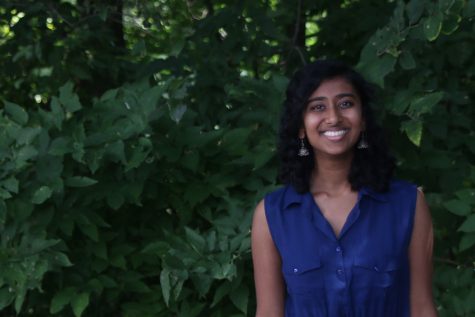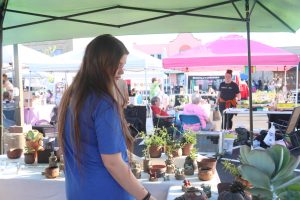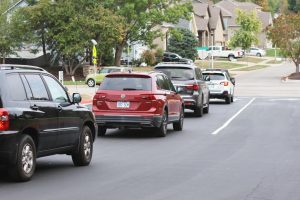Juniors in Spanish V without class options for senior year
A number of students have accelerated beyond the current Spanish pathway due to advanced testing or being native speakers
Using her textbook during a test, junior Zurieli Rojas is an example of what students selected to take the STAMP biliteracy exam looked like on Tuesday, Apr. 20.
May 20, 2018
A group of juniors who have already completed all of the Spanish courses offered at the school have been left without options for pursuing the language their senior year. While students have the option to enroll in Spanish I in eighth grade and complete Spanish V in high school, some students have progressed beyond the current pathway due to being a native speaker or advancing in coursework.
For example, junior Lauren Rothgeb was able to test out of Spanish II and accelerate into Spanish III in her freshman year. Because Rothgeb is currently enrolled in Spanish V, she has few options for continuing to study the language as a senior.
“We don’t really have an answer right now as to what I’m going to be doing, and that’s kind of scary because I love Spanish and I want to continue studying it,” Rothgeb said. “You have to use [languages] if you want to retain them and you have to keep studying them, and it’s hard to do that on your own.”
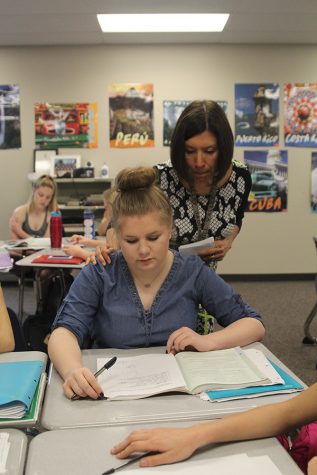
Looking over the shoulder of junior Madelyn Lehn, Spanish teacher Edith Paredes speaks to the class Wednesday, May 2.
On the other hand, junior Madelyn Lehn took Spanish III as a freshman after she earned the first two credits in classes she had taken during her time in the Shawnee Mission school district. The lack of further options to pursue language in USD232, however, is disappointing, according to Lehn.
“It’s kind of frustrating now because we’re at this spot where if you don’t take Spanish next year, you’re going to lose a lot of skills,” Lehn said. “It’s just really frustrating knowing that if we were going into college and trying to take Spanish, we’d be having to relearn things we had already learned.”
For Foreign Languages teacher Edith Paredes, offering a Spanish VI class is desirable but implausible.
“It’s been on my bucket list, because I do have the material to teach it,” Paredes said. “But there’s a process I need to follow through to request that course to be offered. It’s such a select group of kids that it might be difficult to offer VI as a class because it’s so small.”
Rothgeb and Lehn have both looked into different options for continuing to study Spanish. Rothgeb, for example, has researched online college classes or QuickStep, the classes offered by JCCC for credit. Neither were compatible with scheduling.
However, some students have created different opportunities to maintain their knowledge of the language. For example, senior Daniel Nicot learned both Spanish and French from his parents, who are fluent. Because he is a native speaker, Nicot was able to transfer into French III and Spanish III as a freshman, leaving him without either language class as a senior.
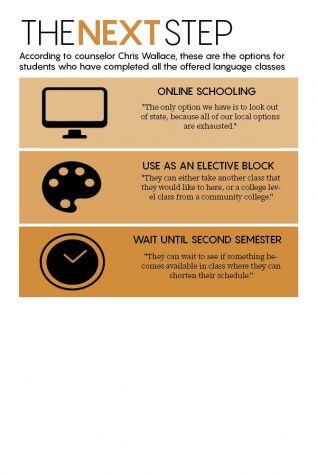 “I kind of had to decide, ‘how am I going to keep this up?’” Nicot said. “So I decided I was going to do Spanish NHS and French NHS. I created the French club for those who couldn’t join the honor society. Through those, even though [meetings] weren’t very often, I could keep up.”
“I kind of had to decide, ‘how am I going to keep this up?’” Nicot said. “So I decided I was going to do Spanish NHS and French NHS. I created the French club for those who couldn’t join the honor society. Through those, even though [meetings] weren’t very often, I could keep up.”
Nicot is one of the few students faced with a lack of options regarding French because there are no French classes offered at the middle school level for students to accelerate beyond.
However, there is no consensus as to what students beyond the pathway should do.
“It’s still all up in the air,” Lehn said. “Spanish VI was like this awesome idea in theory … and that wasn’t plausible. It’s just up to us.”



